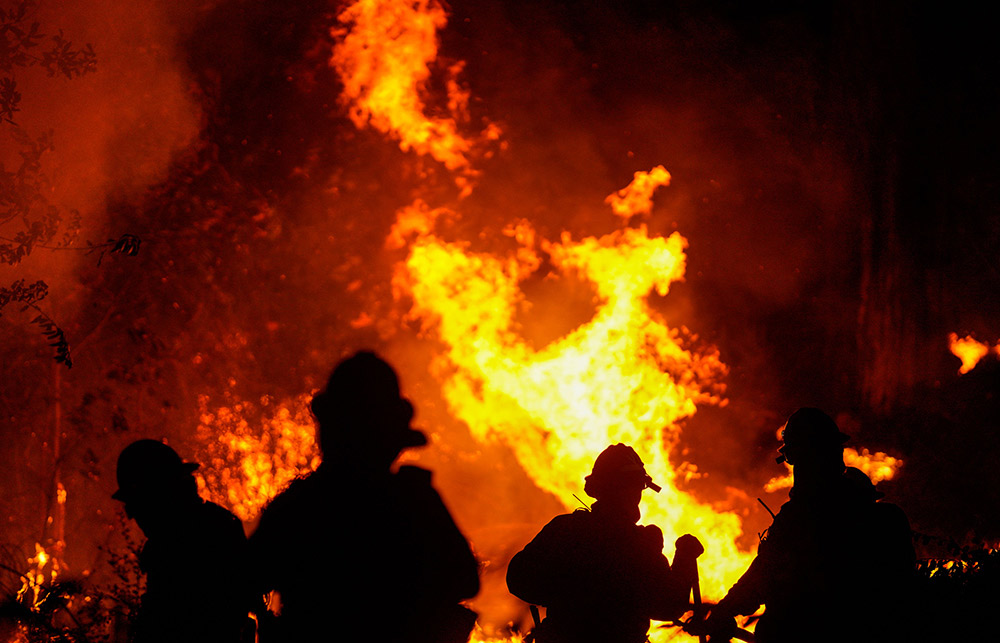硅谷公司能帮忙灭掉加州野火吗?

Technosylva公司正在开发机器学习技术,用于提高消防工作的前瞻性,而不是被动响应。
今年加州的野火季是史上最为严重的一次。克里斯汀•麦克莫罗不会否认这一点。麦克莫罗是加利福尼亚州最大的消防局加州林业和消防局(Cal Fire)的代表。她亲眼见证了野火的严重性。她认为这是史上最致命和破坏最为严重的野火季。
幸运的是,硅谷的科技公司正在行动起来。
约阿奎恩•拉米雷斯和他在Technosylva公司的团队正在开发机器学习技术,用于提高消防工作的前瞻性,而不是被动响应。拉米雷斯的公司为加利福尼亚州林业和消防局主要提供了两项服务:一种是火灾风险预测,通过收集气候、地形、植被等多个因素预测火灾威胁最大的地点;另外一种是预测性地图绘制,帮助消防员了解火势蔓延的方向以及如何应对。
在本期《财富头脑风暴》(Fortune Brainstorm)播客中,麦克莫罗接受了《财富》杂志编辑乐文澜和布莱恩•奥吉夫的采访。她在节目中谈论了这些创新技术如何帮助消防局更好地管理其工作。该播客详细讨论了科技如何改变人类生活。
麦克莫罗说:“这项技术让我们可以在几分钟之内,完成之前需要几个小时甚至几天才能够完成的任务。我们今年已经体会到了它所带来的变化。但未来,等到应急指挥中心的所有意外事件指挥官都能够掌握这种技术,它将真正对我们的实际操作带来巨大的变化。”
Technosylva重点研究数据和机器学习技术的用途,但斯坦福大学的副教授埃里克•阿佩尔在播客中谈论了另外一种有助于提升火灾预防能力的技术。
阿佩尔表示:“有一种普遍的误解认为,火灾没有规律,会在森林里随机发生,但事实上并非如此。绝大部分火灾通常都发生在公路旁,靠近公用事业基础设施。很可惜,在我们的技术诞生之前,没有任何方法可以先发制人阻止火灾发生。所以我们开发了一种类似于凝胶的液体。我们能够将它喷洒在热点区域,在整个野火季期间,它会一直粘在植物上。”
阿佩尔说,过去十年,加州80%的火灾发生在这些热点区域,因此,他的产品可以大幅减少消防局为灭火投入的人力、时间和资金等资源。他在与姐夫闲聊的时候产生了灵感。
在播客17分钟的时候,乐文澜和奥吉夫邀请资深科技行业企业家吉纳•比安基尼,分享了她认为硅谷为什么应该加大力气,开发火灾预测与灭火的创新方法。她认为,为火灾过后的重建找到更简单的方法,同样非常重要。(财富中文网)
翻译:刘进龙
审校:汪皓
Technosylva公司正在开发机器学习技术,用于提高消防工作的前瞻性,而不是被动响应。
今年加州的野火季是史上最为严重的一次。克里斯汀•麦克莫罗不会否认这一点。麦克莫罗是加利福尼亚州最大的消防局加州林业和消防局(Cal Fire)的代表。她亲眼见证了野火的严重性。她认为这是史上最致命和破坏最为严重的野火季。
幸运的是,硅谷的科技公司正在行动起来。
约阿奎恩•拉米雷斯和他在Technosylva公司的团队正在开发机器学习技术,用于提高消防工作的前瞻性,而不是被动响应。拉米雷斯的公司为加利福尼亚州林业和消防局主要提供了两项服务:一种是火灾风险预测,通过收集气候、地形、植被等多个因素预测火灾威胁最大的地点;另外一种是预测性地图绘制,帮助消防员了解火势蔓延的方向以及如何应对。
在本期《财富头脑风暴》(Fortune Brainstorm)播客中,麦克莫罗接受了《财富》杂志编辑乐文澜和布莱恩•奥吉夫的采访。她在节目中谈论了这些创新技术如何帮助消防局更好地管理其工作。该播客详细讨论了科技如何改变人类生活。
麦克莫罗说:“这项技术让我们可以在几分钟之内,完成之前需要几个小时甚至几天才能够完成的任务。我们今年已经体会到了它所带来的变化。但未来,等到应急指挥中心的所有意外事件指挥官都能够掌握这种技术,它将真正对我们的实际操作带来巨大的变化。”
Technosylva重点研究数据和机器学习技术的用途,但斯坦福大学的副教授埃里克•阿佩尔在播客中谈论了另外一种有助于提升火灾预防能力的技术。
阿佩尔表示:“有一种普遍的误解认为,火灾没有规律,会在森林里随机发生,但事实上并非如此。绝大部分火灾通常都发生在公路旁,靠近公用事业基础设施。很可惜,在我们的技术诞生之前,没有任何方法可以先发制人阻止火灾发生。所以我们开发了一种类似于凝胶的液体。我们能够将它喷洒在热点区域,在整个野火季期间,它会一直粘在植物上。”
阿佩尔说,过去十年,加州80%的火灾发生在这些热点区域,因此,他的产品可以大幅减少消防局为灭火投入的人力、时间和资金等资源。他在与姐夫闲聊的时候产生了灵感。
在播客17分钟的时候,乐文澜和奥吉夫邀请资深科技行业企业家吉纳•比安基尼,分享了她认为硅谷为什么应该加大力气,开发火灾预测与灭火的创新方法。她认为,为火灾过后的重建找到更简单的方法,同样非常重要。(财富中文网)
翻译:刘进龙
审校:汪皓
Christine McMorrow won’t deny it: California’s fire season was historically bad this year. As a representative of Cal Fire, the largest fire department in the state, McMorrow has witnessed the severity of these fires firsthand, believing them to be among the deadliest and most destructive on record.
Fortunately, Silicon Valley’s tech community is responding.
Joaquin Ramirez and his team at Technosylva have been developing machine learning technology that makes firefighting efforts more proactive than reactive. Ramirez’s company provides Cal Fire with two main services: its “firecast”––which takes in data on weather, terrain, vegetation, and several other factors and predicts which locations pose the biggest fire threats––and predictive mapping, which gives firefighters insight on the direction a fire will go in and how it will act.
On this episode of Fortune Brainstorm, a podcast detailing how technology is changing our lives, McMorrow speaks with Fortune’s Michal Lev-Ram and Brian O’Keefe about how these innovations make the department’s job more manageable.
“This technology, it allows us to do within minutes what previously would take hours or even days to do,” says McMorrow. “We’ve already seen the difference that it’s made this year. But into the future, once we have this in the hands of all of our incident commanders in our emergency command centers, it’s going to make a really big difference in how we operate on the ground.”
While Technosylva focuses on ways that data and machine learning can be of help, Eric Appel, an assistant professor at Stanford University, joins the podcast to discuss a different type of technology that can assist in preventive efforts.
“There’s this general misunderstanding that fires sort of start willy-nilly at random in the forest, but that’s not really true,” Appel says. “The vast majority of fires happen routinely near roadsides, near utilities infrastructure, and unfortunately, before our technology, there was no way to stop them preemptively. So, we’ve developed a gel-like fluid that you can spray in these hotspot areas, and it sticks on vegetation and remains there throughout the duration of the fire season.”
Appel says over 80% of all fires in California over the past decade began in these hotspots, and thus his product, which was inspired by a casual conversation with his brother-in-law, drastically limits the resources departments spend in terms of both personnel time and money to put out these types of fires.
Around the 17:00 mark, Lev-Ram and O’Keefe bring on longtime tech entrepreneur Gina Bianchini to share her opinion on why Silicon Valley should be focused on more than just innovative ways to predict and fight fires. Finding ways to make rebuilding from fires easier, she asserts, should also be of importance.













